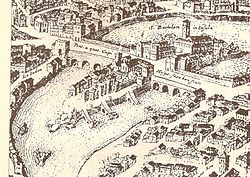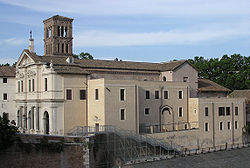“Temple complexes dedicated to Zeus’s grandson Asclepius were the hospitals of the Hellenic period, where patients would be treated with herbal medicine, exercise, healthy food, sacred spring water, singing, dancing, and prayer. His daughter Hygeia is remembered in the English word hygiene”…
Some Romans sailed to Greece once to pray for him to heal their people, they say he transformed himself into a snake and sailed back with them to Rome. Their ship crashed on a little Island in the Tiber so they made a temple for him on that site today, later became a hospital: Tiber Island - Wikipedia
(This is also the origin of the medical symbol of a snake and staff)
Temple of Aesculapius (3rd century BC)
An illustration of the Tiber Island in a 1593 print.
The Basilica di San Bartolomeo all’Isola on Tiber Island.
Tiber Island was once the location of an ancient temple to Aesculapius, the Greek god of medicine and healing.
Accounts say[clarification needed] that in 293 BC, there was a great plague in Rome. Upon consulting the Sibyl, the Roman Senate was instructed to build a temple to Aesculapius, the Greek god of healing, and sent a delegation to Epidauros to obtain a statue of the deity. The delegation went on board a ship to sail out and obtain a statue.
Following their belief system, they obtained a snake from a temple and put it on board their ship. It immediately curled itself around the ship’s mast and this was deemed as a good sign by them. Upon their return up the Tiber river, the snake slithered off the ship and swam onto the island. They believed that this was a sign from Aesculapius, a sign which meant that he wanted his temple to be built on that island.
This location may have been chosen for the Aesculapius Temple because it was separate from the rest of the city, which could help protect whoever was there from plague and illnesses.
The island eventually became so identified with the temple it supported that it was modeled to resemble a ship as a reminder of how it came to be. Travertine facing was added in mid or late first century by the banks to resemble a ship’s prow and stern, and an obelisk was erected in the middle, symbolizing the vessel’s mast. Walls were put around the island, and it came to resemble a Roman ship. Faint vestiges of Aesculapius’ rod with an entwining snake are still visible on the “prow”.
During the Holocaust, some Italian doctors made up a non-existent disease that they told the Nazis about to scare them away from finding some Jews that were sheltered there:


